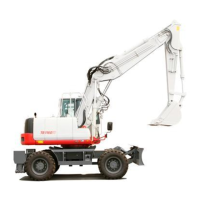3-23
OPERATION
PRECAUTIONS WHEN TRAVELING ON
SLOPES
• Never travel on slopes that are too
steep for the machine to maintain its
stability (maximum gradeability: 35°,
lateral tipping angle: 15°). Note that in
reality, the machine’s stability becomes
lower than the above values depending
on the working condition.
• When climbing a hill, keep the
operator’s seat facing the hillside. When
descending a hill, keep the operator’s
seat facing downhill. In either case,
travel must be done while paying
attention to the ground in front of the
machine.
• When traveling on slopes, lower the
bucket to a height of 20 to 30 cm (8 to
12 in.) above the ground. When climbing
a steep slope, extend the hoe
attachment to the front. In emergencies,
lower the bucket to the ground and stop
the machine.
• When traveling on slopes or grades,
travel slowly in low gear. When
descending a slope, slow down the
engine speed.
• Do not travel at speeds of over 20 km/h
(12.4 mph) on long down slopes.
Release the travel pedal from time to
time to protect the travel motor and
ensure travel stability.
• Do not travel downhill in reverse.
OPERATING PROCEDURES
• Do not change directions on slopes or
traverse slopes. Go down to a flat
surface, and then take an alternative
path.
• The machine may slip sideways even on
a slight slope if it is covered with grass
or fallen leaves, or when traveling on
wet meta plates or frozen surfaces. Do
not allow the machine to position
sideways to a slope.
• If the machine is stalled on the slope,
return each operating lever to the
neutral position before restarting the
engine.
Traveling posture on slopes
Climbing slopes
When climbing slopes of 15° or more,
maintain the machine posture as shown in
the figure above.
Descending slopes
When descending slopes of 15° or more,
slow down the engine speed to travel using
the low-speed travel gear and maintain the
machine posture as shown in the figure
above.

